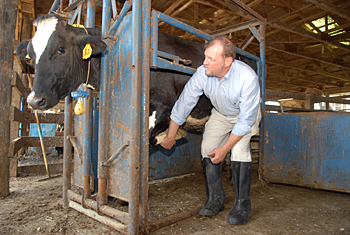
Robert Dyer, associate professor of large animal immunology, infectious disease and production medicine at UD and a large-animal veterinarian, worked with UMBC colleagues to devise the mechanized system for detecting lameness in dairy cattle. The patented system, StepMetrix, is sold by the farm equipment company BouMatic and is being used by dairy farms in the United States and Europe.
“Estimates in the U.S. are that lameness is present in 30-80 percent of all dairy cattle,” Dyer says. “Lameness is here, and it is an increasing problem. It's probably the second or third most costly problem in the dairy industry.”
Lameness in cattle causes such behavior changes as decreased motion and disrupted feeding patterns, and it has detrimental effects on the animals' health and welfare, sometimes leading to lower milk production and reproductive difficulties, Dyer says. He cites industry estimates that each lame cow costs a farmer as much as $300-$350.
The new detection method uses a computerized system of force plates, which are installed on the ground outside the area where the cows are milked. The cows, in turn, are fitted with electronic sensors.
“Every time that a cow walks over the force plates on her way to milking, the plates detect the forces up and down each of the legs,” Dyer says. “It looks at each individual foot as well as the left half of the cow versus the right, the front versus the back.”
Specialized software then analyzes the data collected by the force plates and comes up with a lameness index for each animal, he says, rating the cow as either “sound” or “lame.”
“The system is totally nonintrusive,” Dyer says. “One of the packages even allows an automatic gate to separate an individual cow into a treatment pen, if the machine records a cow as lame two consecutive times.”
He says the researchers developed the dairy cow system in the late 1990s based on their original design for a machine to determine lameness in horses, which proved unsuccessful “because horses didn't like to walk through the chutes of the machine.” They then decided to test the detection system in cows.
The project received grants from the U.S. Department of Agriculture through the National Research Initiative and the Small Business Innovation Research program. Dyer, who at the start of the research was a professor at UMBC, worked with Parimal Rajkondowar--then a UMBC graduate student and now employed with BouMatic as the director of milk parlor engineering--and Uri Tasch, professor of mechanical engineering at UMBC.
In 1999, the experimental machine was finalized, and a software package was developed to accompany it.
“The beauty of the system is that the software will turn around and determine lameness for any number of cows in the herd,” Dyer says. “So you can look at the entire herd for the prevalence of lameness in your herd, and you can also look at changes over time to see if lameness is getting better or worse.”
The machine has the ability to pick up subclinical lesions, which would not be apparent to a farmer and might not yet be causing visible change in gait. There are instances when no visual signs of lameness are present on the hoof--sores or lacerations, for example, which farmers typically look for on a lame cow--yet the cow is in pain, Dyer says.
In June, he and his colleagues at UMBC are scheduled to present their research at the International Symposium on Lameness in Ruminants in Kuopio, Finland.
Dyer notes that only a few, small studies of the system have been conducted in the U.S., but he says data collected in Europe, where the detection system is more widely used due to concerns throughout the European Union about animal welfare, is “highly suggestive that we're headed in the right direction.”
“It is already showing data associated with a 30 percent drop in costs spent on lameness annually,” he says. “I'm not going to say that it is causal yet, but it is certainly associated with the system.”
Plans are to improve the detection model and complete an economic model that Dyer says he believes will demonstrate the system's value to U.S. dairy farmers.
“We started this project 10 years ago, and I have to say, as a vet and as a farm boy, if I can do something like this for cows and help the industry, I will have achieved a lot in my career,” Dyer says.
At UD, significant research efforts are under way not only in the applied methods for automated, continuous detection of lameness in dairy cattle but also in the patho-physiology of lameness. Another aspect of Dyer's research uses molecular-biology tools to understand the physiology of hoof development and to control such serious dairy cow health problems as laminitis, sole ulceration and white line disease.
Article by Katy O'Connell, AG '00
Photo by Danielle Quigley

